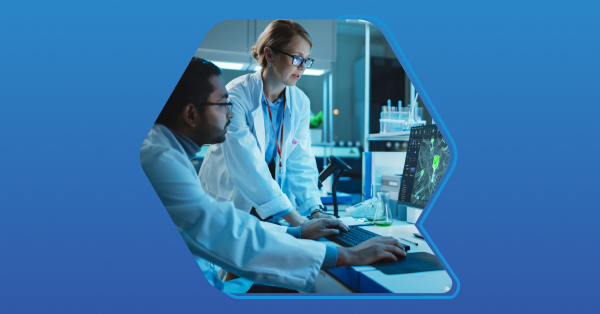HIPAA Compliance For Labs: How Your Lab Can Be Compliant

Thanks to HIPAA (Health Insurance Portability and Accountability Act), personal health-related information must be kept secure, providing patients with an added layer of safety and peace of mind when it comes to their healthcare.
With these extra regulations around privacy comes a burden labs must bear to comply.
This can be especially worrisome in a day and age when it seems private data is constantly being leaked around the web. If your lab works in healthcare or health-adjacent industries, you need to worry about HIPAA.
While the vastness of HIPAA’s requirements can be intimidating, we hope that this article will give you a solid primer on what HIPAA is, how its requirements are broken down, and how software like a LIMS can help you comply.
What is HIPAA?
HIPAA, the Health Insurance Portability and Accountability Act of 1996, is a United States federal law designed to protect sensitive patient health information from being disclosed without the patient's consent or knowledge.
The main goals of HIPAA include:
- Privacy and security of patient information: HIPAA establishes national standards to protect individuals' medical records and other personal health information.
- Health Insurance Portability: This helps ensure that individuals can maintain health insurance coverage when they change or lose their jobs.
- Fraud Prevention and Enforcement: HIPAA has provisions aimed at reducing fraud and abuse in the healthcare system. It also sets standards for the secure transmission of health information.
As you can see, HIPAA is quite broad (and only pieces of it are pertinent to labs). It is divided into several rules which cover these categories:
- Privacy Rules: This sets standards for the protection of individual health information.
- Security Rules: These set standards for securing electronic protected health information (ePHI) - these are broken down further as we will see later on.
- Breach Notification Rules: This requires covered entities and their business associates to provide notification following a breach of unsecured protected health information.
Compliance with HIPAA is enforced by the U.S. Department of Health and Human Services, and violations can lead to substantial fines and penalties. That, and the lengthy list of requirements, can make HIPAA compliance an intimidating subject for most labs.
Read on as we’ll try to break it down for you, and show you how your lab can be compliant.
Does HIPAA Apply to All Laboratories?
HIPAA is synonymous with healthcare, but even if your lab does not operate within a hospital, you may need to comply.
The following laboratories are covered by HIPAA:
- Clinical laboratories: These labs process tests on clinical specimens to obtain information about a patient's health to aid in diagnosis, treatment, and prevention of disease. Since they handle Protected Health Information (PHI), they must comply with HIPAA regulations.
- Reference laboratories: Often specializing in more complex testing, reference labs receive specimens from other healthcare entities. They are directly involved in handling PHI and, thus, must adhere to HIPAA.
- Hospital-based laboratories: Labs that are part of a larger hospital system come under HIPAA because they are part of a Covered Entity (the hospital) that processes PHI.
- Pathology laboratories: These labs examine bodily fluids, tissues, and organs to diagnose diseases. They handle PHI extensively, making HIPAA compliance mandatory.
The following types of labs may still need to comply even if they are not directly related to a hospital:
- Research laboratories: If they have access to PHI for healthcare research and are part of a Covered Entity or a Business Associate of one, they need to comply with HIPAA. However, de-identified data in research settings may not be subject to HIPAA rules.
- Public health laboratories: These labs may need to comply with HIPAA if they process PHI. However, there are exceptions within HIPAA for public health activities under certain circumstances.
If your lab falls under these categories, then you need to make sure you comply with HIPAA.
HIPAA Privacy Requirements
HIPAA’s privacy rule is designed to protect information that falls under Protected Health Information (PHI). PHI is any data that can be used to identify an individual as well as signifying their current health status, payment history, or provisions of healthcare.
That includes things like:
- Name
- Address
- Phone numbers
- Email addresses
- Social security number
- Medical records
- Health insurance beneficiary numbers
- Financial information
- Photographs
For clinical laboratories, test results fall under protected health information which makes the handling of sensitive test and patient data critical. It’s important your lab understands what information you have is sensitive and follows the security rules we’ll outline next to protect this information from unauthorized access.
HIPAA Security Requirements
The security rules in HIPAA revolve around privacy and security measures in place for PHI that your lab interacts with.
Within these categories are sets of rules that are:
- Required: They must be followed as closely as possible
- Addressable: There’s a bit more leeway to implementation
These required rules cover:
- Physical security of the building
- Data backups and contingency plans
- Device control
- Workstation control
- Access control
- Authentication
While the addressable rules cover:
- Workforce security (being authorized or supervised)
- Security awareness and training (password management)
- Facility access controls (security plans and maintenance records)
- Device and media control (data backup and storage)
- Access control (automatic logoff), transmission security (encryption)
The HIPAA security rules are broken into three categories:
- Administrative safeguards
- Physical safeguards
- Technological safeguards
Let’s walk through these categories and their respective rules in depth.
HIPAA Administrative Safeguards
HIPAA’s administrative safeguards cover the administration and management of staff and information in a lab.
This includes rules for:
- Managing security and handling breaches.
- Having staff that is adequately trained and ready to manage the security of information.
- Keeping PHI clean of identifying data.
- Training the workforce and evaluating a company’s safety protocol all involve the responsibility of management for PHI.
While the burden of these rules largely falls on the admin staff, having all staff in your lab understand them, and their importance helps to ensure compliance within your lab. As we’ve said: the better your staff understands the rules of HIPAA, the more compliant you will be.
HIPAA Physical Safeguards
HIPAA’s physical safeguards are another key piece of its compliance requirements.
HIPAA’s physical safeguards include:
- The security of the facility.
- The security of devices that sensitive data can be accessed on (for example, a laptop or phone).
- Whether your facility has physical guards and safety protocols (alarms, locked doors, maintenance records).
- Verification and auditing of these safeguards.
- Workstation privacy - for example, privacy screens for workstations with access to ePHI and password protection.
- Policies around the disposal of hardware used to store/transport PHI. Note that backup and storage rules for said hardware are addressable rather than required.
- Security and supervision over employees with access to PHI, as well as regular security training for staff.
- A contingency plan in place for emergencies (such as a natural disaster). This covers rules for backing up and storing data in the event data disappears.
While these guidelines primarily pertain to the physical security of the lab, it’s worth noting that if you use cloud-based software then sensitive data could be accessed from anywhere. As organizations move to the cloud, this does beg the question of security when your data is stored on a server outside of your facility and could (theoretically) be accessed from anywhere.
We will touch on this later when we discuss choosing software vendors as you manage HIPAA compliance.
HIPAA Technical Safeguards
Lastly, we have the technical safeguards in HIPAA’s requirements. The technical safeguards cover how data can be accessed and stored.
This includes rules around:
- Data only being accessed only by authorized personnel.
- The ability to record and audit data.
- The ability to identify irregularities.
- Audits and logs to identify potential breaches.
- Policies in place to ensure that PHI cannot be accessed, altered, or destroyed improperly.
- Unique logins for individual users.
- Automatic logoffs (addressable).
- Verification that users are who they claim to be (through the use of a PIN for example).
- Transmission security for cloud-based storage.
Between these three categories, the most important takeaway is that only authorized persons should be able to view or alter PHI. Between administrative, physical, and technical safeguards, you must protect PHI that your lab handles as the fines and damage to your reputation can be devastating in the event of a breach.
While this overview is fairly comprehensive, you can review the full set of requirements from the HHS website for more information.
How a LIMS Helps Your Lab Achieve HIPAA Compliance
As you can see, how PHI is handled is a core component of HIPAA compliance - and managing this across several systems can make compliance prohibitively difficult.
A Laboratory Information Management System (LIMS) can play a key role in helping your laboratory maintain HIPAA compliance through various features designed to protect patient privacy and secure PHI.
QBench LIMS was built with privacy in mind, and we are proud to provide enterprise-grade security features for our labs. Here’s how Here are the ways a LIMS can support HIPAA compliance in your lab:
- Access control
- Audit trails
- Data encryption
- Data integrity and backups
- Compliance reporting
- PHI minimization
Access Control and User Authentication
Managing who has access to PHI and eliminating unauthorized access are keys to ensuring the security of PHI in your lab.
QBench provides role-based access controls to ensure only authorized personnel can access PHI, based on their roles and responsibilities within the lab. This minimizes the risk of unauthorized access to sensitive information. Multi-factor authentication (MFA) can add an additional layer of security by requiring users to verify their identity before logging in. This further protects PHI from unauthorized access and a breach.
Audit Trails
An audit trail allows you to view records of all interactions within your LIMS, including who has accessed or modified PHI and when. In the event of a breach, this detailed audit trail is crucial for investigating access and changes to PHI for reporting purposes.
Data Encryption
Whenever data is transmitted from your LIMS, there’s a risk that it could be intercepted by an unauthorized third party. Data encryption ensures that when data is stored and transmitted from your LIMS it is unreadable from unauthorized individuals. This helps to protect data and minimize the chance of a breach. QBench encrypts all data between your lab and its platform via HTTPS for maximum security.
Data Integrity and Backups
QBench LIMS is backed up nightly for up to seven days giving your lab the peace of mind that PHI is not lost in the event of improper deletion. This is a core component of ensuring that PHI is protected and your lab can maintain the integrity of its data. Recall from above that regular, secure backups of PHI help ensure that data can be recovered in case of a loss, such as from hardware failures, natural disasters, or cyber-attacks.
Compliance Reporting
A LIMS can help your lab generate reports to document compliance with various HIPAA requirements, such as audit trails, access controls, and breach response efforts. These reports can be vital during internal audits or investigations by regulatory bodies.
PHI Minimization
With custom fields, a LIMS like QBench can be configured only to collect and retain the minimum necessary amount of PHI required for legitimate laboratory purposes. This helps to keep your lab in line with HIPAA's minimum necessary rule.
By implementing a LIMS like QBench, your lab can significantly enhance its ability to meet the standards of HIPAA compliance. A LIMS can be an extremely powerful asset for any lab looking to improve its security and ensure the utmost integrity of its data.
There are many LIMS platforms available, we compiled a list of the best LIMS on the market to help you make the right choice.
Which LIMS are HIPAA Compliant?
Not every Laboratory Information Management System (LIMS) is inherently HIPAA compliant. Compliance with HIPAA depends on how the LIMS is implemented, used, and maintained within the laboratory environment, as well as whether the LIMS provider offers the necessary features and supports to enable compliance.
QBench is proud to share that we are HIPAA compliant (along with SOC2 and ISO 17025).
We actively monitor our systems and have up-to-date information on our compliance and security posture on our trust website.
Stay HIPAA Compliant with QBench LIMS
A LIMS is a fantastic asset for any lab looking to meet the standards of HIPAA compliance.
QBench LIMS is proud to be HIPAA compliant and support labs in their compliance. Click the button below to schedule a demo and see QBench LIMS in action.








